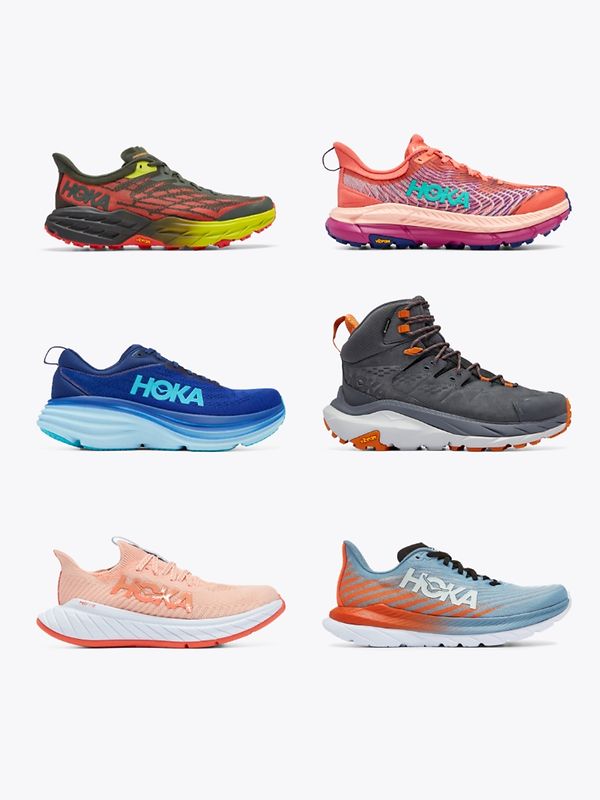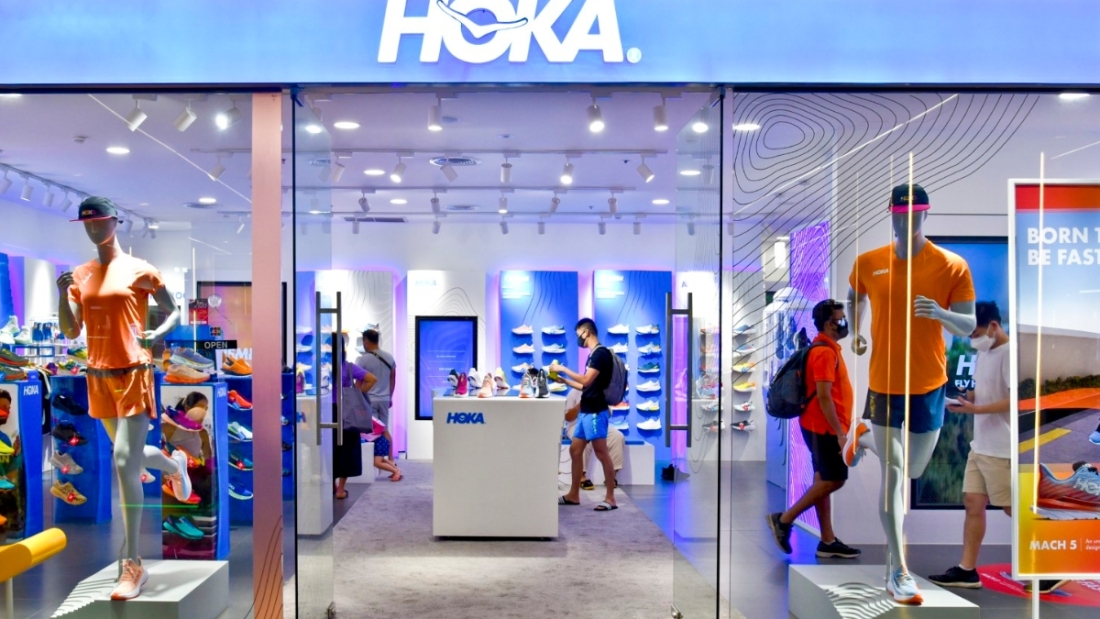HOKA is a running shoe company that has taken the industry by storm in recent years. With their oversized midsole, meta-rocker geometry, and J-frame technology, HOKA has offered runners a unique approach to running shoes that has proven successful. After buying a few pairs for our families and seeing them become more mainstream, we will take a closer look at HOKA’s history, shoe designs, and impact on the running community, as well as compare them to other running shoe brands.
The History of HOKA
Founded in 2009 by Nicolas Mermoud and Jean-Luc Diard in Annecy, France, HOKA was initially created to design shoes that would help an aging Diard continue running. Mermoud and Diard noticed that most running shoes were flat and heavy, causing pain and muscle fatigue during runs. They set out to create a shoe with maximum cushioning and a unique rocker shape to facilitate a more efficient stride.
Founding and Early Years
After years of research and development, HOKA released their first shoe, the Mafate, in 2010. The Mafate was different from traditional running shoes due to its oversized midsole, which provided superior cushioning and a more comfortable ride. HOKA quickly gained popularity among ultrarunners, who saw the benefits of the added cushioning and support for long-distance runs.
As HOKA continued to grow, they expanded their product line to include shoes for various types of running, including trail running and road running. They also began to collaborate with professional athletes to create shoes that met the specific needs of their sport.

The Evolution of HOKA’s Shoe Designs
Over the years, HOKA has continued to innovate, introducing new shoe models with different features and technology to improve runners’ experiences. The Clifton, released in 2014, was a breakthrough model that offered a lightweight design while still retaining the cushioning that HOKA was known for. This shoe quickly became a favorite among runners of all levels, and HOKA’s popularity continued to grow.
In 2016, HOKA released the Speedgoat, a trail running shoe designed in collaboration with ultrarunner Karl Meltzer. The Speedgoat quickly became a top choice for trail runners due to its superior traction and cushioning. HOKA also introduced the Fly Collection, a line of shoes designed for speed and performance, in 2019.
The Bondi, released in 2019, added the J-Frame technology, which added more stability to the shoe. This technology helped to reduce the risk of injury for runners, making it a popular choice among those who are prone to overpronation.
Key Milestones and Achievements
HOKA’s popularity and success have grown rapidly over the years, with the company gaining numerous awards and accolades. In 2019, HOKA won the “Innovative Product of the Year” award at the Running Awards for the Fly Collection. HOKA also had a strong showing at the 2021 US Olympic Trials, with several athletes sporting HOKA shoes and making the Olympic team.
Today, HOKA continues to innovate and push the boundaries of what is possible in running shoe design. With a focus on comfort, cushioning, and performance, HOKA has become a favorite among runners of all levels and continues to be a driving force in the running shoe industry.
HOKA’s Unique Approach to Running Shoes
What sets HOKA apart from other running shoe brands is their unique approach to shoe design. HOKA shoes have several key features that make them stand out. But what makes these features so special? Let’s dive in and take a closer look.
The Oversized Midsole
The oversized midsole was the feature that started it all for HOKA. The thick cushioning provides better shock absorption and comfort, making it a top choice for ultrarunners who need extra cushioning for long-distance runs. But the oversized midsole isn’t just for long-distance runners. It also provides a comfortable ride for everyday runners who want a little extra cushioning in their shoes.
One of the benefits of the oversized midsole is that it helps reduce the impact of each footstrike. This means less stress on your joints and a lower risk of injury. The cushioning also helps reduce fatigue, allowing you to run longer and more comfortably.
The Meta-Rocker Geometry
The meta-rocker geometry is a unique design that promotes a smoother and more efficient gait cycle. The rocker shape of the shoe allows for a more natural forward motion and encourages a heel-to-toe transition. This means less energy wasted on each stride and a more efficient use of your muscles.
The meta-rocker geometry also helps reduce the risk of injuries. By promoting a more natural gait cycle, it reduces the stress on your joints and muscles. This can help prevent common running injuries like plantar fasciitis, shin splints, and IT band syndrome.
The J-Frame Technology
The J-frame technology is a new addition to HOKA’s shoe design and adds more stability to the shoe. The J-frame is a firmer foam structure that wraps around the heel and medial side of the shoe to prevent overpronation and improve stability. This means a more secure fit for your foot and a lower risk of rolling your ankle.
The J-frame technology also helps improve your running form. By preventing overpronation, it encourages a more natural gait cycle and reduces the risk of injuries. It also helps distribute your weight more evenly across your foot, reducing the stress on any one area.
Overall, HOKA’s unique approach to running shoe design has made them a popular choice for runners of all levels. Whether you’re a seasoned ultrarunner or just starting out, HOKA shoes can help you run more comfortably and efficiently.
Comparing HOKA to Competitors
HOKA has made a strong impact on the running shoe industry, and its parent company’s Deckers Outdoor ($DECK) stock price has show glimpses of that since June 2022. It’s important to consider how they compare to other brands and what has created their formula for success. Here are some key comparisons.

HOKA vs. Traditional Running Shoes
HOKA’s oversized midsole and rocker design set them apart from traditional running shoe brands. Traditional shoes tend to be more flat and offer less cushioning, meaning they may not be the best option for those seeking maximum comfort and support.
The oversized midsole of HOKA shoes provides runners with more cushioning, which can reduce the impact on joints and muscles during a run. This extra cushioning can also help runners feel more comfortable during long-distance runs, as it reduces the risk of developing blisters or other foot injuries.
Additionally, the rocker design of HOKA shoes promotes a more efficient running stride, which can help runners conserve energy and maintain proper form throughout their run.
HOKA vs. Minimalist Running Shoes
Minimalist running shoes offer less cushioning and support and are designed to promote a more natural stride. While minimalist shoes have their benefits, they may not be the best choice for runners who need extra cushioning or support for long-distance runs.
HOKA shoes provide runners with the extra cushioning and support they need to run comfortably and safely over long distances. Additionally, the rocker design of HOKA shoes can help runners maintain proper form and reduce the risk of injury, which may not be the case with minimalist shoes. However, for runners who prefer a more natural running experience, minimalist shoes may still be a good option.
HOKA vs. Other Maximalist Brands
HOKA is not the only brand that offers maximalist shoes. Other brands such as Altra and Brooks also offer shoes with thick cushioning and unique designs. While there may be some similarities in design, HOKA’s unique features, such as the meta-rocker geometry and J-frame technology, set them apart from their competitors.
The meta-rocker geometry is a unique design feature that promotes a more efficient and natural running stride, while the J-frame technology provides extra support and stability to the foot. These features make HOKA shoes a top choice for runners who need extra cushioning and support during their runs.
The Impact of HOKA on the Running Community
HOKA has made a significant impact on the running community, both among professional athletes and everyday runners.
The Rise of Ultrarunning and HOKA’s Influence
Ultrarunning has become increasingly popular in recent years, and HOKA’s cushioning and support have made them a popular choice among ultrarunners. HOKA has sponsored several ultrarunning events and athletes, cementing their place as one of the top brands in the ultrarunning community.
Professional Athletes Embracing HOKA
HOKA has also gained popularity among professional athletes across different sports. In the running world, athletes such as Jim Walmsley and Hayden Hawks have achieved success while sporting HOKA shoes. In the triathlon world, athletes such as Tim O’Donnell and Heather Jackson have also had success while wearing HOKA shoes.
Everyday Runners’ Testimonials
Lastly, everyday runners have also reported positive experiences with HOKA shoes. Many runners have reported that the shoes provide extra cushioning and support, reducing pain and fatigue during runs. Some runners have also reported that HOKA shoes have helped improve their running speed and efficiency.
Conclusion
HOKA has emerged as a major player in the running shoe industry, offering unique designs and technology that have resonated with runners across different levels. Their oversized midsole, meta-rocker geometry, and J-frame technology have proven successful in providing added comfort, support, and stability to runners.
While they face competition from other major brands such as Nike, Adidas & others, HOKA has done a tremendous job setting themselves apart and implementing comfort and utility. and will likely continue to be a popular choice among other niches. Our next bet is you will see them more on Casual Fridays in the workplace and among other niches.
Hoka has done it again. https://t.co/RJiuRqESlG
— VICE (@VICE) June 3, 2023



Leave A Comment